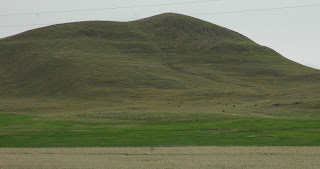After a great supper at Cracker Barrel Restaurant, our travel the next day continued across southern Utah on I-84. The altitude continued to climb as we traveled up the high plateu area that stretches across Idaho and Wyoming before starting a long descent in Nebraska.
Idaho was rolling hills and plateus with cultivated farm lands dotted through the area. Lots of horses, cattle, and sheep.
Remember to double click on the pictures to enlarge them.
Changes in air pressure at different altitudes really become apparent with thing you don't think of. For instance what happens to a bag of potato chips when it get to an altitude of 4,500 feet? It becomes hard as a rock from pressure inside the bag. Be careful when you open it. Also be careful when you open catsup or mustard, or you'll be cleaning it off the ceiling. Our sleep-number mattress bed was as hard as a rock. Pressure on the gauge said "100". Thats as high as it would go.
Elk was also abundant. But of course its not hunting season yet.

Just before leaving Idaho, we discovered the long-lost Lake Bonneville. Where we were standing was underwater by a 20,000 square mile lake that covered this area and down into Utah. The only part of the lake that is left is the Grat Salt Lake in Utah. On the surrounding hills, you can still see the shore lines of the lake that was here about 20,000 years ago.
After leaving Idaho, we drove into northern Utah. Scenery was different with snow capped montains on the left, and on the right the level plateu of the lake bed that has the Great Salt Lake.
In the picture of the large hill with the cattle at the bottom-right, you'll notice the lines going across the hill near the top. This is one level of the large lake (Lake Bonneville) that covered the area 20,000 years ago.
We didn't have time to drive to Salt Lake City to see the Mormon Tabernacle Temple, so we went to Brigham, Utah, and visited the historic Box Elder Tabernacle. Consturction started in 1865 and was completed in 1890. It is still in active use today. The downtown section of Brigham looks almost exactly as it did in the 1800's.
About 30 miles west of Brigham, UT, is Promotory Point. It was here where the Union Pacific Railroad, started from Omaha, NE ; and the Central Pacific Railroad, started from Sacramento, Ca. ; finally met at this point. After six million railroad spikes, and six years, the final golden spike was driven, and on May 10, 1869; the country had its first transcontinential railroad.

 The plate between Barbara's feet reads: "The last tie laid on the completion of the Pacific Railroad, May, 1869". the plate is the exact spot where the last spike was driven. The original gold spike is now at the Stanford University in the art museum.
The plate between Barbara's feet reads: "The last tie laid on the completion of the Pacific Railroad, May, 1869". the plate is the exact spot where the last spike was driven. The original gold spike is now at the Stanford University in the art museum. This is a painting of the original ceremony.
This is a painting of the original ceremony.Utah was a beautiful place to visit.
Stay tuned for more
















